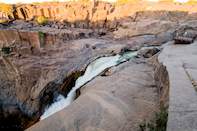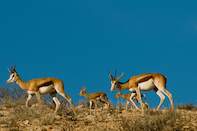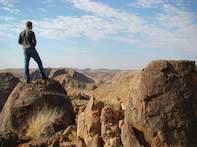Augrabies Falls National Park
Augrabies is a magical Green Kalahari Desert destination with lots of interesting sights and places worth visiting in the area. As the town is relatively small and caters to the basic needs of travellers, it’s the ideal stopover for holidaymakers on their way to nearby destinations.

One such destination is the Augrabies Falls National Park, which surrounds a magnificent waterfall unleashed from rocky surroundings. The 18 km abyss of the Orange River Gorge is the main attraction, showcasing a series of beautiful yet dangerous gushes of water. The gorge is about 240 m deep and for avid geologists, it provides an impressive example of erosion in a granite basement.
Originally, the area’s first inhabitants called the Augrabies Falls Ankoerebis, meaning the “place of big noises”, most likely due to how loud the waterfall was. The first communities were the Khoi and San, who live in domed huts and sourced water from the Orange River nearby. The Green Kalahari Desert was their domain until the Trekboers settled in the now-established town of Augrabies.
The Augrabies National Park offers guests various activities other than staring at the great waterfall - there are hiking trails, a restaurant, picnic facilities and informative boards on plant and animal life of the area. There is also a game drive available, which allows visitors to see indigenous wildlife like the black rhino, klipspringer and meerkats.
Kgalagadi Transfrontier National Park

The Kgalagadi Transfrontier National Park is the desert adventurer’s next stop if so desired; it is a mystical oasis in the Green Kalahari Desert, where an abundance of indigenous plant and animal life thrive in the arid conditions.
The park is a conservation area and home to 250 bird species and a multitude of other animals. Geographically, it spans over two countries, namely South Africa and Botswana. It was once two separate parks, but was amalgamated in the 21st century. Unfortunately, in 2014, a portion of the Botswana park was sold for gas-fracking, which is a process that removes specific gas from the earth but is harmful to the environment.
The terrain consists of red sand dunes, dry riverbeds and plant life such as baobab and camelthorn trees and kalahari shrubs. Predators include lions, cheetahs, African leopards, and hyenas. Herbivores that frequent the park are herds of springbok, blue wildebeest, eland and red hartebeest. Smaller creatures such as meerkats, tortoises, raptors and lizards call the park home.
Visitors can enjoy day and night game drives through the park, as well as hiking trails, sand dune surfing and ample accommodation options.
Nearby Towns

Two nearby towns worth visiting are Kakamas and Riemvasmaak. They will be of particular interest to historians who enjoy collecting information on the history and culture of an area. Kakamas was founded in 1898 and lies on the banks of the Orange River.
It is known for its ancient water wheels from the 17th century that are still in use today - local farmers use it to water their crops. The town sells locally grown fruits such as peaches and table grapes, grown in the fertile ground of the Orange River.
Riemvasmaak is a tiny town that is famous for its natural hot springs. The springs are located in a deep gorge that is surrounded by excellent hiking, mountain biking and 4x4 trails. It is believed that the area’s first inhabitants, the Khoi and San, used the hot springs for its healing properties. Today, it is a popular tourist destination with lots of character.
 The name Augrabies is derived from the African word “oukurubes”, meaning the noise-making place. This is an apt description of the Augra...
The name Augrabies is derived from the African word “oukurubes”, meaning the noise-making place. This is an apt description of the Augra... In an odd finger of South Africa in the Northern Cape, jutting north and surrounded by Botswana in the east and Namibia in the west, is the ...
In an odd finger of South Africa in the Northern Cape, jutting north and surrounded by Botswana in the east and Namibia in the west, is the ...